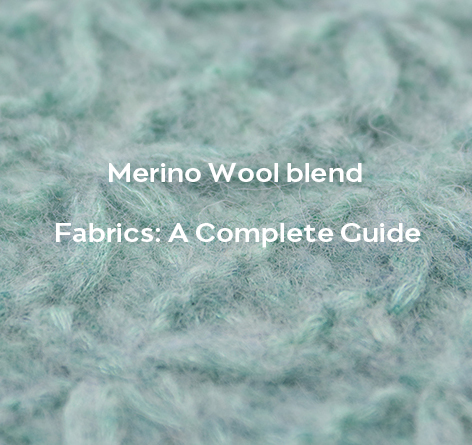Wool is appreciated for its warmth, elasticity, and natural feel, but combining it with other fibers has additional benefits. By combining materials like alpaca or acrylic, wool blends are custom made for specific purposes, including achieving a silky sheen, increasing durability, or making the yarn more affordable and easier to take care of.
Blended wool fibers serve a variety of purposes, each combination releasing unique creative opportunities. Whether you’re attempting to warmth, style, or budget, wool blends have a specialized, customizable outcome that satisfies various requirements.
This overview gives you the foundation to understand the different types of wool blends and their benefits, this will prepare you for a more in depth study of which combinations are best for different projects.
Wool-Mohair Blend: Strength and Sheen
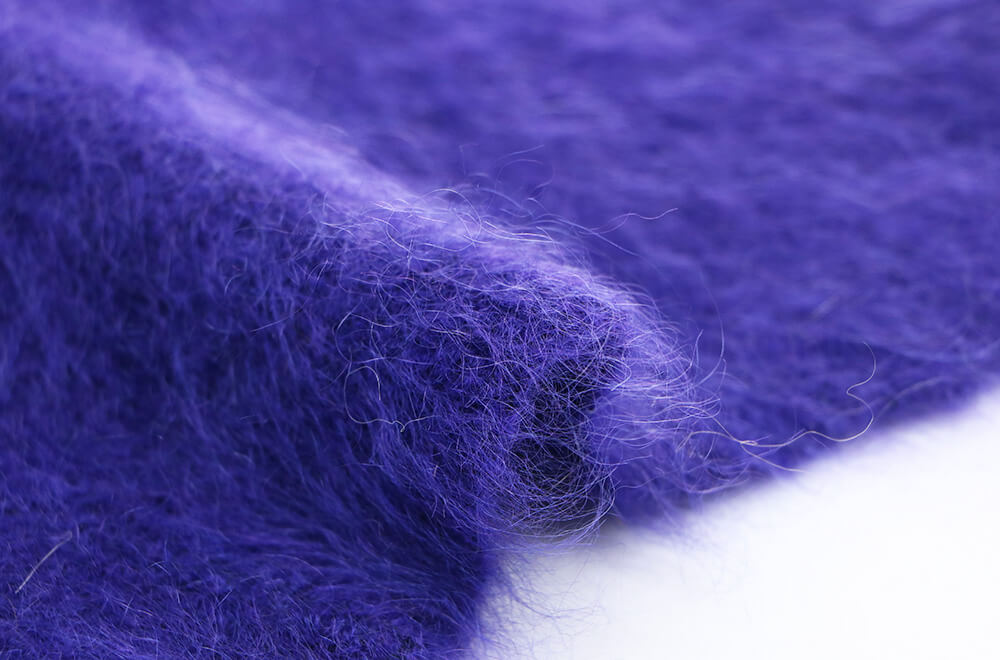
The wool-mohair blend combines the insulating properties of wool with the distinct shine and smooth texture of mohair, this creates a yarn that is both lightweight and durable. This blend is beneficial for high-end fashion articles that require sophistication, warmth, and longevity.
Mohair is associated with its luxurious feel and sheen. When combined with wool, it increases the yarn’s shine and smoothness, making it aesthetically pleasing. This sheen imbues wool-based yarn with a luxurious, refined appearance, while the addition of mohair diminishes the overall weight of the yarn without compromising warmth. The outcome is a yarn that possesses the best of both fibers-wool’s insulation and mohair’s smooth, silken composition.
The wool and mohair blend is frequently employed in high-end fashion design where both durability and aesthetics are of paramount importance. This amalgamation is common in high-end collections and is typically found in clothing like:
- Luxury Sweaters: The lightweight warmth and luxurious sheen of this yarnmakes it an ideal choice for superior sweater design.
- Elegant Scarves and Shawls: The softness and brilliance of mohair is responsible for elevating these accessories, this makes them ideal for high-end fashion.
- Outerwear: The combination of wool and mohair is frequently employed in winter coats and jackets, this combination provides exceptional insulation without adding bulk, this is ideal for outerwear that doesn’t feel heavy.
The combination of mohair and wool increases the appeal of designs; it provides a material that is both durable and beautiful. It’s especially popular for high-end collections that have both aesthetic appeal and functionality as a result.
Wool-Alpaca Blend: Softness and Warmth
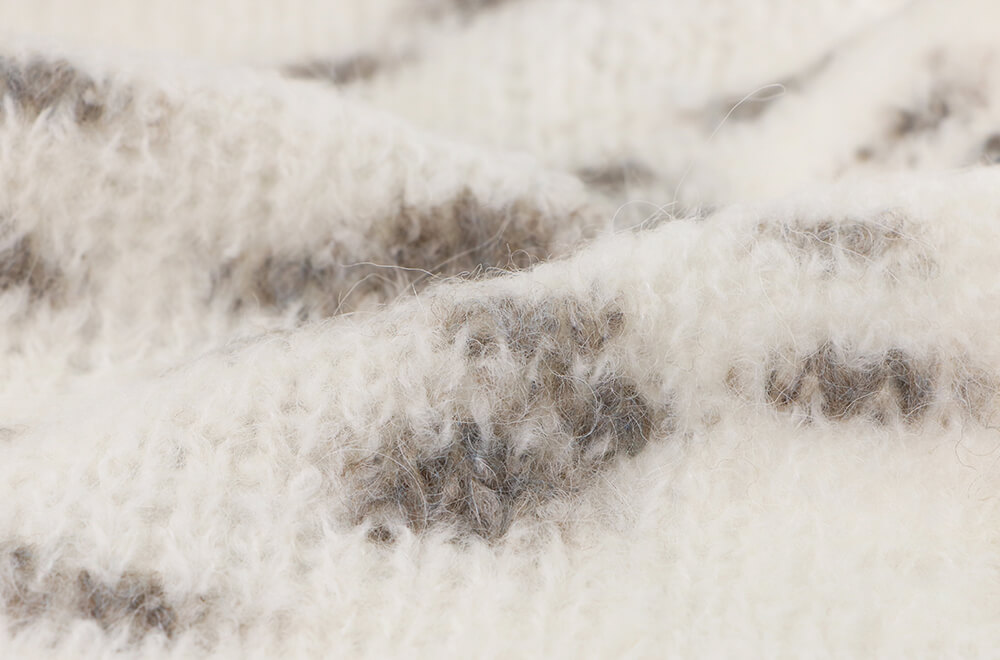
A wool-alpaca blend is cherished for its exceptional softness, warmth, and hypoallergenic properties. The combination of alpaca’s fiber with wool creates a textured yarn that is ideal for sensitive skin, it provides the perfect combination of softness, insulation, and durability.
Alpaca fiber is well-known for its softness, which is often compared to cashmere, and is significantly warmer than sheep wool, despite being heavier in weight. When combined with wool, alpaca increases the overall sensation of the yarn by adding a smooth, silky texture and superior insulation. The hollow design of alpaca’s fibers accommodates air, this design promotes warmth without increasing the weight. This causes the wool-alpaca blend to have a not only more warming effect, but also a softer and lighter nature, this results in a more inviting and luxurious feel than pure wool alone.
The softness and temperature of the wool-alpaca blend makes it ideal for clothing and accessories that are near the skin.
Some of the most effective uses of this blend include:
Knitwear: Sweaters, cardigans, and shawls made from wool-alpaca combinations have a uniquely soft and inviting experience, ideal for cold weather.
- Scarves and Wraps: The allergy-prone properties of alpaca make wool-alpaca scarves a great option for those with sensitive skin.
- Outerwear: Other types of wool-alpaca blends are also employed for lightweight, yet warm, outerwear like coats and ponchos. These items provide both style and comfort.
These garments are appropriate for both casual attire and superior fashion, they provide warmth and comfort in cold climates.
Additionally, wool-alpaca blends are often considered to have a more beneficial effect on sensitive skin than pure wool. Alpaca fibers are naturally allergen-free, because they have a lower concentration of lanolin oils than sheep wool, which can lead to some skin irritation. This causes wool-alpaca yarn to be an ideal substitute for people who feel itchy from the traditional wool. The smoothness of alpaca’s fiber also decreases the chance of itching, this is ideal for people who want a soft, comfortable garment.
Wool-Acrylic Blend: Affordability and Versatility
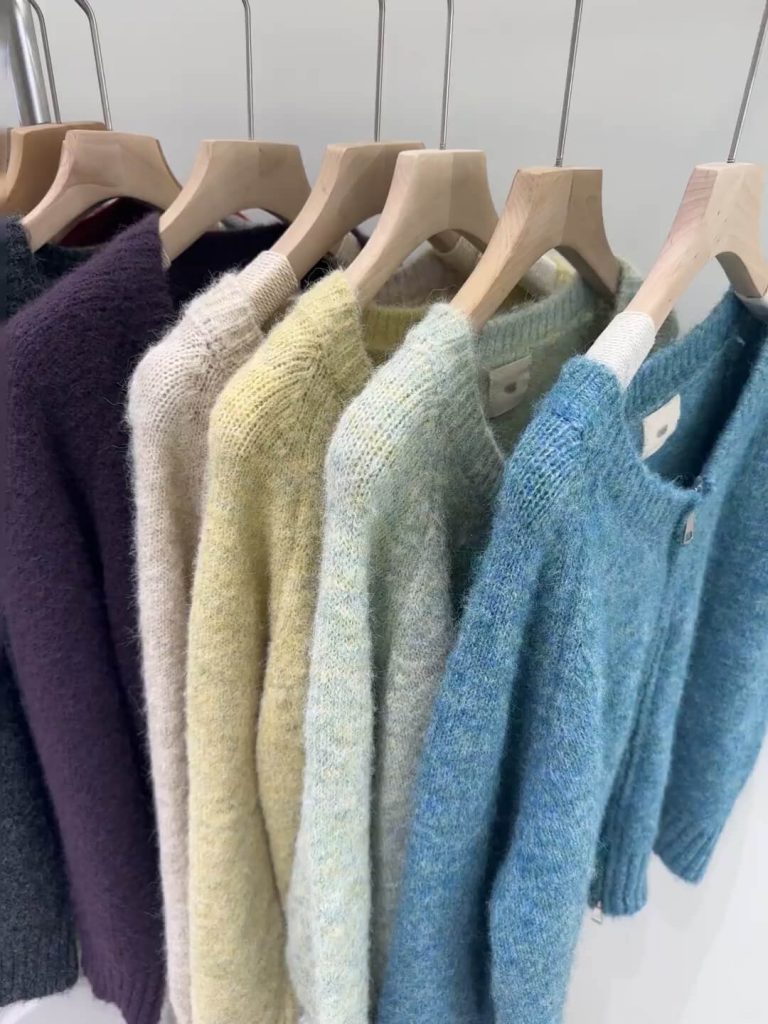
A wool-acrylic mixture is popular in the fashion industry, it combines the warmth and softness of wool with the practicality and ease of care that acrylic provides. This amalgamation is beneficial to someone who are budget-conscious and want to produce a large amount of goods, it has a combination of practicality and comfort.
The expense of wool-acrylic combinations is primarily caused by the lower cost of acrylic, a synthetic fiber that is derived from chemical compounds. Acrylic is more practical to produce than natural fibers like wool, this causes it to be a popular solution to create clothing at a lower expense. Additionally, acrylic decreases the ease of processing the fibers in the yarn, which benefits consumers by providing them with a low-maintenance fabric. Unlike wool alone, which is typically washed by hand or dried, the combination of wool and acrylic is able to withstand regular cleaning, this will maintain the softness of the garment and its shape over time.
However, despite the fact that it’s budget-friendly and simple to utilize, the long-term viability of wool-acrylic blends is not as long as superior wool blends like wool-alpaca or wool-mohair. One of the greatest downfalls is that this blend is susceptible to pilling, small fiber clusters are formed on the fabric’s surface. Acrylic blends, especially those with a higher acrylic content, are more likely to be pilled than natural fibers. This can reduce the appearance and duration of clothing, particularly when exposed to friction.
While acrylic promotes the stretchiness and shape retention of wool-acrylic combinations, it lacks the same tensile strength and resilience as natural fibers. The higher the acrylic content, the greater the probability that the fabric will pill, this will adversely affect the overall duration of the garment. For garments that want a longer lifespan, combinations with less acrylic or higher quality wool are more successful.
Cashmere-Wool Blend: Luxury and Softness
Cashmere wool blends are the epitome of textile luxury, combining softness, warmth and light. The addition of cashmere to wool increases the fabric’s porosity, this increases the fabric’s smoothness and lightness. Cashmere is finer and more refined than wool traditionally, it increases the warmth of the wool while creating a fabric that is exceptionally soft.
The extravagant quality of the cashmere-wool blend is attributed to its capacity to balance with warmth and weight. Wool is well-known for its insulating properties, this enables the wearer to remain warm in cold temperatures. When combined with cashmere, the fabric produced is not only insulating but also breathable and lightweight. This choice is beneficial for high-end clothing, as both style and comfort are important.
While pure wool is valued for its durability and natural warmth, the cashmere-wool blend provides a more refined experience. The softness of Cashmere is imbeded into the fabric, which provides a silky smoothness that enhances the clothing’s feel. The combination promotes a degree of comfort and sophistication that is recognized in high-end fashion. Cashmere also has the effect of altering the fabric’s stretchiness, this effect helps the fabric maintain its original shape over time without becoming excessively bulky or stiff.
This extravagant combination is typically used in high-end sweaters, cardigans, shawls, and coats. Cashmere-wool is typically employed for scarves and wraps, the material is soft and inviting, and the purpose is to enjoy the warmth and comfort of the item. The versatility of the combination is sufficient to create a variety of clothing that are both fashionable and functional, these garments are ideal for combined use during the cooler months.
Following the instructions associated with the care of cashmere-wool clothing is essential to maintaining the luxurious sensation of the garments. Gentle hand-washing with mild detergents that are intended for use with wool is recommended to maintain the fabric’s quality. To prevent the fibers from being adversely affected, clothing should be air-dried on a flat surface, and the storage of the garment in a breathable bag will help to maintain the garment’s shape and duration.
As the demand for high-end fibers increases, the sustainability of cashmere production has come under scrutiny. The ethical procurement of cashmere is now being more frequently considered, this is primarily due to the increasing popularity of environmentally friendly farming methods that have a minimum of impact on the environment. By encouraging farms that prioritize environmentally responsible practices, the fashion industry can continue to enjoy the benefits of cashmere while minimizing the environmental impact that it has.
Comparing Wool Blends: Which One is Right for You?
Selecting the appropriate wool blends for your project is crucial to achieving the desired blend of texture, warmth, durability, and hypoallergenic attributes. Different combinations are appropriate for different climates, skin types, and projects, so it’s important to consider these factors in detail. Below, we discuss some of the key factors to consider when choosing a wool blend for your next project of knitting or design.
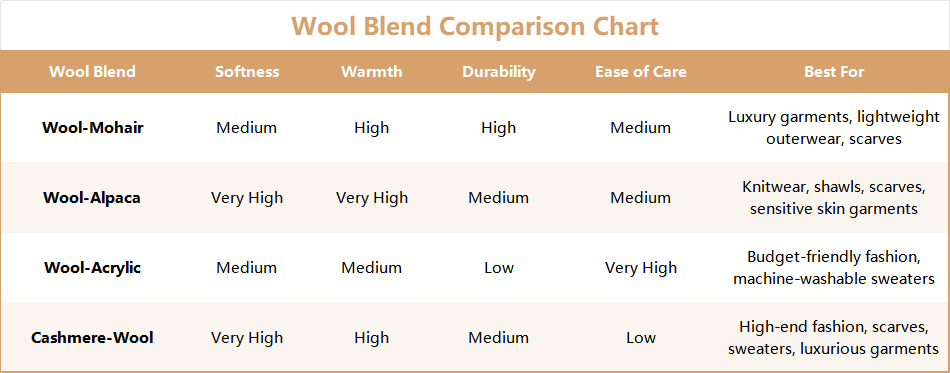
1. Texture and Softness
The softness and texture of a wool blend has a significant effect on the comfort and feel of a garment, especially for projects like sweaters, scarves, and baby clothes that will be directly exposed to the skin. Cashmere-wool and wool-alpaca combinations have a soft, luxurious feel, which is ideal for sensitive skin. Alpaca is associated with its luxurious feel and the property of hypoallergenic, it is therefore a great choice for people who have a tendency to skin irritation.
For projects that require a rougher texture, like coats or items that need extra longevity, wool-mohair blends are likely to be successful. Mohair provides a slight sheen and tensile strength, which enhances the textile’s structure, though it may be less soft than other combinations.
2. Warmth and insulation
Different types of wool blends have different levels of warmth, which is influenced by the fiber’s capacity to collect air. For the best insulation in cold climates, wool-alpaca blends are excellent because of the alpaca’s natural fiber-rich cavities that trap warmth without increasing weight. Of course, cashmere-wool blends are also extremely warm and lightweight, with cashmere providing superior insulation and a superior feel.
In moderate climates, blends with acrylic or other synthetic fibers are sufficient in providing warmth while also being lighter and more breathable. These blends are popular for clothing that transitions between seasons or for layering pieces that are wearable during any season.
3. Durability and Pilling Resistance
Durability is important, especially for items that are used frequently, such as sweaters, blankets, or accessories. Wool-acrylic blends are often selected because of their resilience, machine-washability, and cost, although higher acrylic content can lead to pilling, this is especially common in areas that are subject to frequent contact. Wool-based blends that are made from wool and mohair are typically durable and can stand a long amount of use, though they may need special precautions to avoid wear and tear.
If long-lasting wear is a priority, consider blends with lower acrylic content or ones that incorporate stronger fibers, like mohair. Other wool blends may also withstand proper care, but since the fibers are delicate, these garments may need to be handled with care to avoid pilling or damage to the fibers.
4. Hypoallergenic Properties
Those with sensitive skin or allergies should consider using hypoallergenic fibers. Alpaca is naturally unable to produce lanolin, which causes wool-alpaca to be a popular choice for people who experience itching or irritation with traditional sheep wool. Cashmere is another exceptional option for skin that is sensitive, it’s typically more soft and less likely to cause irritation. Conversely, blends that contain different percentage of wool fibers may have a different level of comfort, it’s therefore important to test as many small swatches as possible in order to make sure they are compatible with the sensitive skin.
5. Yarn Gauge and Project Suitability
The gauge of the yarn’s fibers, such as such as Woolen, Semi-worsted, Worsted, has a significant impact on its potential applications for different projects.
For instance:
- Woolen: Bested in design for clothing that is both warm and structured, such as sweaters and cardigans.
- Semi-worsted: It’s effective for lightweight sweaters, hats, and other projects that have a medium to high density.
- Worsted: Perfect for detailed patterns, base layers, shawls, and lighter accessories where drape is important.
Some blends are better suited to chunky knits, for example, mohair-wool blends are chunkier. so always consider your project type and pattern of knitting when choosing a combination of yarn.
Selecting the appropriate wool blend is dependent on balancing factors like softness, warmth, durability, and Hypoallergenic properties that are based on the intended use. For instance, cashmere-wool or wool-alpaca blends are wonderful for high-end clothing or sensitive skin, while wool-acrylic is practical and budget-friendly for everyday wear.
Need help deciding on the best blend for your project? Our team at HD Merino offers free professional advice on choosing the ideal yarn for your specific needs. From softness to warmth and durability, we can guide you toward the best selection to bring your creative vision to life.
Environmental and Ethical Considerations in Wool Blends

Selecting wool combinations that concur with environmental and ethical values is increasingly popular with consumers and brands themselves. As the number of people who are aware of sustainable practices and the humane treatment of animals increases, the focus is increasingly on the production of wool and the certification processes that guarantee the responsible sourcing of this material. Here, we simply discuss some of the key factors that should be considered when making environmentally friendly and ethically-based wool combinations.
1. Eco-Friendly Wool Combination
Not all wool combinations are created with the same degree of environmental impact. While wool is itself renewable, biodegradable, and less energy-intensive to create than synthetic fibers, the components of the blend, such as acrylic, have different environmental concerns. Acrylic is derived from petroleum and has a larger carbon footprint than natural fibers. Conversely, blends that contain fibers like alpaca or cashmere have a lower environmental impact if purchased responsibly.
2. Ethical Acquisition and Animal Welfare
For sustainable wool blends, ethical sourcing standards are essential. Certifications like RWS for wool, as well as standards for mohair, alpaca, and cashmere, help ensure humane treatment and responsible environmental practices. Choosing blends with these certifications supports animal welfare and sustainable fiber production.
3. Synthetic Fibers and Environmental Impact
Blends containing acrylic or other synthetic fibers have an environmental effect due to their non-biodegradable composition and petroleum-based sources. Acrylic fibers are said to release microplastic particles during washing, these particles can then be accumulated and released in waterways and ecosystems. As a result, when choosing wool-acrylic combinations, it’s important to balance the practicality and cost of acrylic with its environmental effects. For those committed to eco-friendliness, minimizing synthetic fiber use or opting for lower-percentage blends can reduce this impact.
For personalized guidance on choosing sustainable, ethically sourced wool blends, HD Merino offers free consultations to help you find the best options for your designs while staying environmentally conscious.
Conclusion
Consider the project’s purpose, the desired level of softness, warmth, and care requirements to choose the perfect blend. For eco-conscious creators, opting for blends with certifications in ethical sourcing and sustainable practices adds peace of mind and ensures a responsible choice. Whether crafting for luxury, everyday wear, or eco-friendliness, understanding these blends allows you to make an informed decision.
If you’re unsure which blend best suits your project, contact HD Merino for expert guidance on yarn selection. We offer personalized advice tailored to your design and budget, helping you achieve the perfect balance of quality, cost, and care for any creation.



